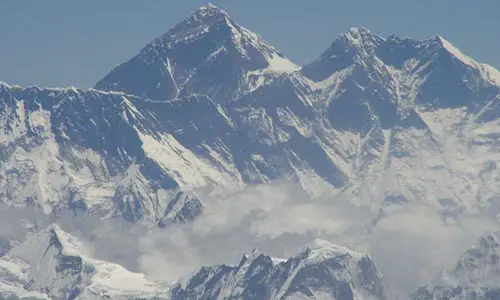How the Himalayas Were Formed
Millions of years ago, the continent of Gondwana consisted of Africa, South America, Australia, Antarctica, and India. Over centuries, The Indo-Australian plate broke away and collided with the Angara or Eurasian plate. The impact displaced what was once the Tethys Sea and threw up mountain ranges such as the Karakoram and the Himalayas. The Himalayas stretch for 2900 kms, forming a natural border between India and Tibet.
Earthquakes
The constant friction of tectonic plates results in a series of earthquakes felt not only in the Himalayan region but far beyond. The earliest recorded earthquake was in Kathmandu in 1255 when one-third of Nepal’s population perished. An earthquake in Srinagar in 1555 killed thousands. Another such calamity devastated Kathmandu again in 1833, destroying over four thousand buildings in the capital. The devastating temblor in Nepal this year was felt as far as Lahore in Pakistan, New Delhi in India, Lhasa in Tibet, and Dhaka in Bangladesh.
Highest Peaks in the World
This majestic mountain range is home to nine of the world’s tallest peaks. Mount Everest is the highest peak at 29,035 ft. It was named after Sir George Edward Everest, a British surveyor, who first recorded the location of the peak in 1841. Other peaks in this region ranging from 26,000 to 28,000 ft. are Kanchenjunga,
Lhotse , Makalu, Cha Oyu , Dhaulagiri, Manaslu, Nanga Parbat, and Annapurna. Compare these peaks with the highest peaks in South America and North America – Mount Aconcagua at 22,834 ft. and Mount McKinley at 20,320 ft.
Climate
This great barrier of mountains protects India from cold winds from the north, contributing to its moderate climate. Barring the foothills, the Himalayas enjoy two seasons – summer and winter. The lower slopes have a temperature of 30 degrees Celsius in the summer months and about 18 degrees in the winter months. However, the higher the elevation, the colder it gets; and winter temperatures can range from below freezing to 15 degrees depending upon the altitude. The western Himalayan slopes and the foothills experience monsoon weather from June to September.
Flora
The Himalayan slopes are covered with forests, tropical at the foothills, turning into deciduous and ultimately coniferous at greater heights. At very high altitudes, there is no forest cover. Sub-tropical pine, teak, shisham, and sal forests are found in Kashmir, Uttar Pradesh, Nepal, Bhutan, and Himachal Pradesh. It is recommended to take a stroll through the “Valley of Flowers,” a world-heritage site located in Uttarakhand. Situated at 11,500 ft., it is the habitat of the snow leopard, musk deer, and black bear. True to its name, a walk there will reveal nature in all its glory – flower-bedecked meadows, cataracts, and tiny streams.
Fauna
The lower Himalayas teem with animal and bird life. India offers many game sanctuaries, one of them being Corbett National Park. Here you will see rhinoceros, bison, elephants, and if you are lucky, even a tiger.
Lakes
Most Himalayan lakes are situated below an altitude of 16,400 ft. The exception is Kailash Mansarovar at the foot of Mount Kailash, which rises over 21,000 ft. and lies in Tibet. Mount Kailash was the seat of Lord Shiva and is still a very holy pilgrimage destination for Hindus.
Hindu Pilgrimage Centers
No Hindu is complete until he has visited the four holy places called “Chardham.” The places are Badrinath, Kedarnath, Yamunotri, and Gangotri, all located in the Himalayan state of Uttarakhand. Badrinath is dedicated to Lord Vishnu. Kedarnath is dedicated to Lord Shiva. Gangotri is believed to be the source of the river Ganga (Ganges). Ganga was a goddess who, angered by the evil king Badrinath, turned herself into a river. Later Lord Shiva gathered her into his matted locks trying to appease her. Yamunotri is the source of the river Yamuna. Yamuna was the sister of Yama, God of death. A dip in her icy waters is said to ensure a peaceful death.
Hill Stations
Hill stations are retreats to cooler climes from the searing summer heat. The British founded these townships to escape the torturous summers of Northern India. Still today, they are popular destinations for summer holidays. People flock to Srinagar, Shimla, Nainital, Ranikhet, Mussoorie, Darjeeling, and many other spots to enjoy a vacation. Many of them can only be reached by road or rail.
Adventure Tourism
Besides pilgrimages, the Himalayas offer other activities such as mountain climbing, trekking, and even skiing. For instance, Manali, which is located on the banks of the river Beas, offers river rafting. Paragliding in the Kulu Valley is a popular sport, as is trekking. The Rohtang Pass offers skiers a variety of slopes. Manali has a school of mountaineering that enjoys international patronage.
The Himalayas are the youngest mountains, yet the tallest. Their sheer majesty evokes both reverence and awe.











Leave a Reply